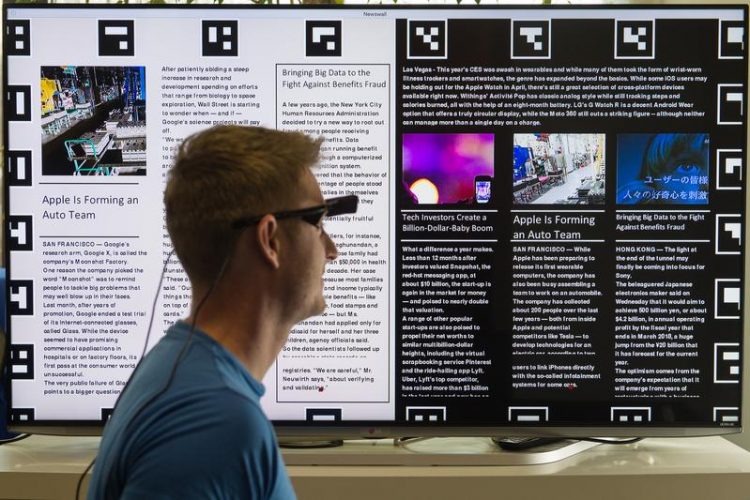Reading speed harnessed to automatically control text display rates

Computer scientists in Saarbrücken have developed a software system that recognizes how fast a text is being read and then allows the text to scroll forward line by line at the right speed. Credits: Oliver Dietze
The research team will be showcasing its project from March 16th to March 20th at the Cebit computer expo in Hanover (Stand E13, Hall 9).
Average readers manage about 200 words per minute. Once they reach the end of a page in a book, they turn the page. Things are somewhat different when reading a text on a display. In this case, the reader might use the mouse to pull up the next section of text to be read. This is something the team of computer scientists from Saarland University and the German Research Center for Artificial Intelligence (DFKI) would like to change.
Their solution is based on the movement of the reader’s eyes. The system analyses the reading speed and uses the result to automatically adjust the speed at which the text is displayed on the screen. ‘We use commercially available eye-tracking glasses,’ explains Christian Lander, a doctoral research student who works at the DFKI’s Innovative Retail Laboratory and is supervised by Professor Antonio Krüger.
The glasses are equipped with two cameras: a small infrared camera that faces the user and tracks the movement of the pupil in the user’s right eye. The other camera faces forward and records the image that the user is looking at. The software combines the images from the two cameras and is thus able to precisely determine the direction of eye gaze.
‘We have combined the image capture technology with a computational procedure that we developed in the media informatics research seminar,’ says Lander. ‘It computes the average speed at which a paragraph is read. The method involves registering how quickly the reader’s eye travels from left to right along a line of text and then downward to the next line.’ The system recognizes any change in the reader’s reading speed and adjusts the text scrolling speed accordingly.
The system currently allows three readers to simultaneously read the same text on a single display. ‘Each reader has their own small window in which they can read the text at their preferred speed,’ explains Lander. It is conceivable that in a few years’ time this technology will be used on the sorts of large displays found in railway stations or shopping centres.
At the moment, tracking glasses are needed in order to register the wearer’s gaze. However, the system could be installed in future in other more user-friendly wearable devices such as Google Glass. The method can also be adapted for use on smaller displays or with electronic books.
Computer science and informatics at Saarland University
The Department of Computer Science forms the core of the informatics landscape at Saarland University. A further seven internationally renowned research institutes are located in the immediate vicinity on campus. As well as the two Max Planck Institutes for Informatics and for Software Systems, the Saarbrücken campus is also home to the German Research Center for Artificial Intelligence, the Intel Visual Computing Institute, the Center for IT-Security, Privacy and Accountability (CISPA) and the Cluster of Excellence ‘Multimodal Computing and Interaction’.
Christian Lander is one of 370 doctoral research students currently studying at the Saarbrücken Graduate School of Computer Science.
Questions can be addressed to:
Christian Lander
Innovative Retail Laboratory (IRL) / DFKI
E-mail: christian.lander(at)dfki.de
Tel.: +49 (0)681 85775-5009
Editor:
Gordon Bolduan
Science Communication
KIS – Computer Science Competence Center Saarland
Tel: +49 (0)681 302-70741
E-mail: bolduan(at)mmci.uni-saarland.de
Note for radio journalists: Studio-quality telephone interviews can be conducted with researchers at Saarland University using broadcast audio IP codec technology (IP direct dial or via the ARD node 106813020001). Interview requests should be addressed to the university’s Press and Public Relations Office (+49 (0)681 302-2601).
Media Contact
More Information:
http://www.uni-saarland.deAll latest news from the category: Trade Fair News
Newest articles

Combatting disruptive ‘noise’ in quantum communication
In a significant milestone for quantum communication technology, an experiment has demonstrated how networks can be leveraged to combat disruptive ‘noise’ in quantum communications. The international effort led by researchers…

Stretchable quantum dot display
Intrinsically stretchable quantum dot-based light-emitting diodes achieved record-breaking performance. A team of South Korean scientists led by Professor KIM Dae-Hyeong of the Center for Nanoparticle Research within the Institute for…

Internet can achieve quantum speed with light saved as sound
Researchers at the University of Copenhagen’s Niels Bohr Institute have developed a new way to create quantum memory: A small drum can store data sent with light in its sonic…





















